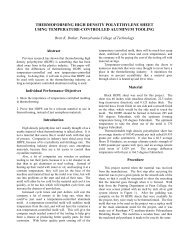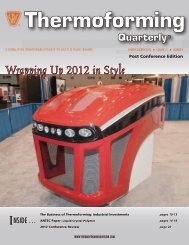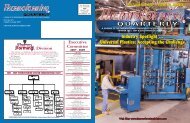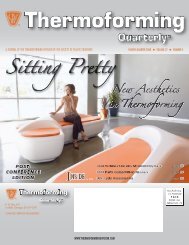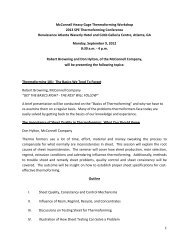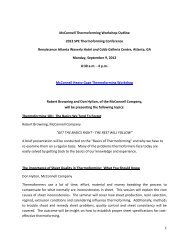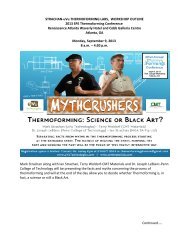Third Quarter - SPE Thermoforming Division
Third Quarter - SPE Thermoforming Division
Third Quarter - SPE Thermoforming Division
You also want an ePaper? Increase the reach of your titles
YUMPU automatically turns print PDFs into web optimized ePapers that Google loves.
Illustration #8.<br />
1. Absolutely no mark on the outside indicating any separate<br />
mold sections.<br />
2. Uniform material thickness over the entire plastic part.<br />
The design answer was to build loose undercut parts that would<br />
slide up inclined ramps on the main body of the mold [see<br />
Illustration 9]. However, the most important requirement of the<br />
Illustration #9.<br />
mold design was to guarantee the “no mold mark” on the finished<br />
parts over large production runs. An additional challenge was<br />
how to get the two heavy moving sections easily up the slide until<br />
the plastic part was freed, and then how to “gently” get the mold<br />
sections back down the ramp without slamming the bottom rests.<br />
Achieving the “No Mark” Requirement<br />
The two end sections were cast of aluminum as was the main<br />
body of the mold. They had cooling lines cast in them, connected<br />
to the lines in the main body of the mold with flexible woven steel<br />
tubes [see Illustration 10]. It was important that the aluminum<br />
behind the bronze plates, on which the two moving sections slid,<br />
were temperature-controlled with cooling lines. (Author’s Note:<br />
NEVER build a mold with sliding sections moving on similar<br />
metals. They will cause galling of the aluminum surfaces and<br />
metal pieces will come off of the contact area, which will soon<br />
lead to binding.)<br />
Notice in Illustration 10 how the two guides are built in to control<br />
the positioning of the sliding part. Also, the pivoting lock in the<br />
center of the bronze plate that secures the end section when it is<br />
down in the forming position is turned by an electric motor: one<br />
direction to lock, and reverse to unlock when the part is formed<br />
and cooled. It is critical to remember not to use the hollow of the<br />
Illustration #10.<br />
mold as a vacuum chamber! When the vacuum comes on, and the<br />
ambient air pushes the hot sheet onto the mold, it will tend to move<br />
any loose part no matter how tightly it is locked in place, because<br />
there is no equal pressure pushing back.<br />
When designing a mold with loose sections that must not leave<br />
a mark, you will be amazed at how well it will work if you run a<br />
vacuum manifold through the mold and run flexible tubes from the<br />
manifold to the inside surface of the mold at all of the vacuum holes.<br />
During forming, the inside of the mold has the same ambulant air<br />
pressure as the room in which it is being formed and the inside of<br />
the mold is pushing back against the pressure caused by the vacuum<br />
forming of the sheet. Thus the loose section will not move during<br />
the vacuum forming period.<br />
To handle the weight of the two moving end sections, each one has a<br />
steel cable fastened to it that runs through a hole in the bronze plate,<br />
over a pulley, and is secured to a counterweight within the body of<br />
the mold. The counterweight hangs in a tube, and as the part begins<br />
to dismount the mold, the ends moved up the slides quite easily<br />
due to the falling weight inside the mold. When the formed plastic<br />
part undercuts have cleared the moving mold sections, they slide<br />
down the ramps slowly due to the resistance of the weights. Each<br />
counterweight reduces the sliding section of the mold from a true<br />
34 pounds to a lifting and falling weight of only 4 pounds.<br />
What is probably the most common undercut in today’s<br />
thermoforming industry is the pressure formed housing with a<br />
return at the base (either partial or completely around the base.)<br />
Since the pressure formed housing is formed into a cavity mold, the<br />
return is formed with an over-hanging aluminum section at the top<br />
of the mold [see Illustration 11 – the brown section at the bottom of<br />
the mold is a piece of a formed part that protects the molds textured<br />
surface when it is not in use].<br />
I have selected this particular example because of the complexity<br />
of the total design, Notice the severity of the undercuts in the four<br />
corners, each more than 1" deep [see Illustration 12]. In order to<br />
form these corners with adequate material thickness, I designed<br />
four articulating pushers in the corners of the plug. These pushers<br />
were pieces of aluminum stock with wooden shapes on the forming<br />
ends. The aluminum was shaped to fit into the plug where it had a<br />
pivot point, and the other end extended out of the side of the plug<br />
where it rested on the top surface of the hot sheet as the plug pushed<br />
the material down into the cavity of the mold [see Illustration 13<br />
8 <strong>Thermoforming</strong> QUArTerLY



